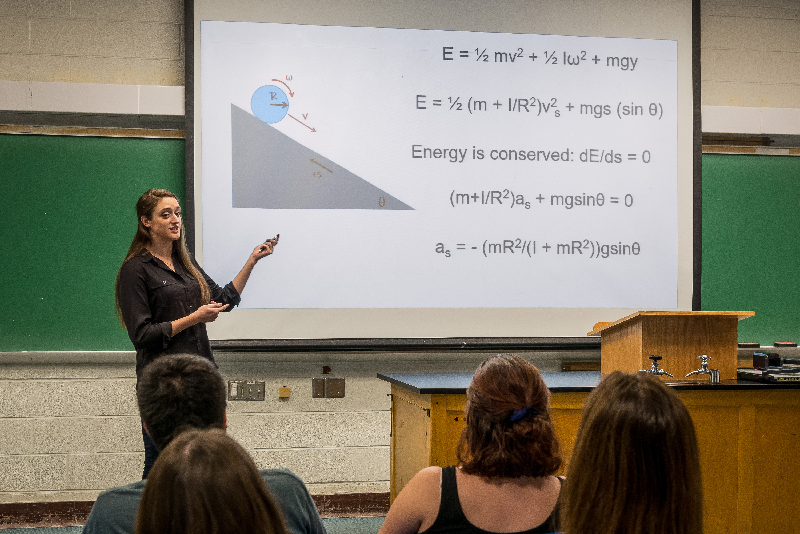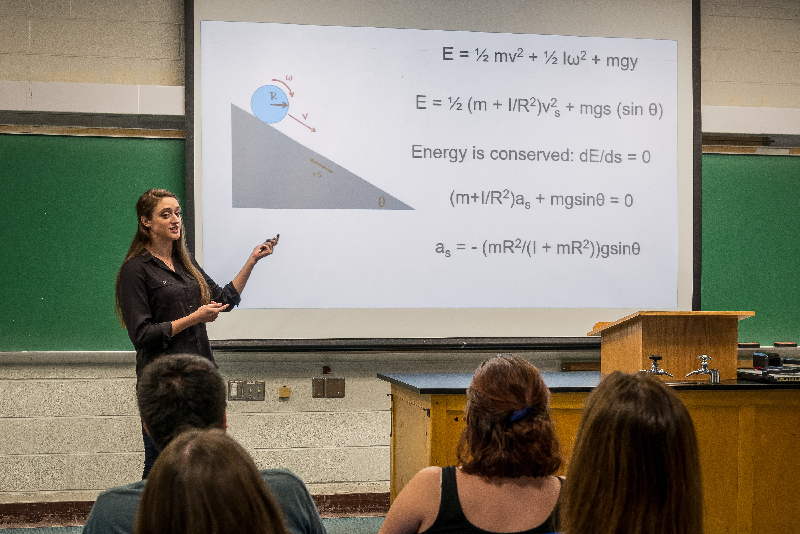Teaching Energy Before Forces
Forces, and Newton’s three laws that describe how they work, are usually regarded as central components of classical mechanics. But in a new proposal, a team of physicists suggests that students learning mechanics be introduced first to concepts involving energy and that forces be taught by deriving them from the energy equations. The researchers now present evidence that this “energy-first,” calculus-based introductory curriculum improves performance of students with weaker math skills and boosts grades in later coursework in physics and engineering.
Previous work has shown that one of the challenges in learning about mechanics is the need to master force vectors, with which many students struggle [1]. Christopher Fischer of the University of Kansas, Lawrence, and his co-workers reasoned that starting with a nonvector (scalar) quantity like energy might be easier than the traditional approach of learning forces first.
For example, the conservation of energy means that, under the right conditions, the sum of kinetic and potential energy remains a fixed quantity. A few basic applications of calculus (differentiation) lead from this energy equation to the equations of motion for the system, as encapsulated by Newton’s laws. This derivation of mechanics from energy concepts is not new; it’s equivalent to an alternative to the Newtonian formulation that was developed in the 19th century by Irish mathematician William Hamilton, known as Hamiltonian mechanics.
Fischer and colleagues have devised an introductory curriculum that takes this approach to explain many of the important topics in physics, from simple kinematics to oscillatory and rotational motion. In each case, differential calculus is involved in deriving equations of motion from energy equations. “We are still teaching them forces,” Fischer explains, “but only after students have time to understand classical mechanics in the framework of ‘easier’ mathematics,” meaning scalars rather than vectors. The curriculum also gives a calculus-based derivation of momentum and thermodynamics. Fischer has published two introductory textbooks that take the energy-first approach [2, 3].
To test the value of this approach, the researchers took advantage of the fact that the University of Kansas offers two introductory physics courses, PHSX210 and PHSX211. The courses have essentially the same content but slightly different structure and tutors, and the math ability of students in each course is about the same.
In 2015, the energy-first curriculum was introduced into PHSX211, but not PHSX210, and between 2016 and 2018, all students were given a standardized conceptual physics exam at the beginning and end of each semester. For students strongest in math, the participants in PHSX211 did only slightly better. But for students with the lowest math scores, the PHSX211 students performed significantly better than those who took PHSX210. What is more, those PHSX211 students who took subsequent physics and engineering courses got better grades on average in those later classes.
The researchers caution that more work will be needed on larger samples of students to be fully confident that the curriculum content, and not some other factor, was behind the differences in performance. In particular, the class size for PHSX210 was more than twice as large as that of PHSX211, and PHSX211 had an extra 50 minutes of class time per week; each of these differences could potentially influence student learning.
Assuming the new curriculum is responsible for the exam score differences, the team has not yet identified the reasons for the improvements, although they have some ideas. “Our current working hypothesis is that tasking the students with using calculus repeatedly throughout PHSX211 has helped the students to improve their understanding of and skills with both physics and calculus,” says Fischer.
There are other introductory physics curricula that place emphasis on teaching energy [4, 5], says Benjamin Dreyfus of George Mason University in Fairfax, Virginia, a specialist in physics education, “but this is the first one I have seen that is calculus focused,” using energy concepts to derive force laws. He sees this paper as “a proof of concept that it was successful in this one particular context” and agrees that further research is needed to determine how broadly the conclusions apply.
Physics educator David Meltzer of Arizona State University in Tempe is not convinced that the current data can establish that the improvements are due to the curriculum changes. He thinks that the differences between the two courses, especially in classroom time, make the comparison ambiguous and that the sample sizes are too small for strong conclusions to be drawn. However, he thinks there is a “strong case” for further analysis of whether energy-first truly makes a difference.
This research is published in Physical Review Physics Education Research.
–Philip Ball
Philip Ball is a freelance science writer in London. His latest book is How Life Works (Picador, 2024).
References
- N.-L. Nguyen and D. E. Meltzer, “Initial understanding of vector concepts among students in introductory physics courses,” Am. J. Phys. 71, 630 (2003).
- C. J. Fischer, The Energy of Physics, Part I: Classical Mechanics and Thermodynamics, 2nd Edition (2019)[Amazon][WorldCat].
- C. J. Fischer, The Energy of Physics, Part II: Electricity and Magnetism, 2nd Edition (2020)[Amazon][WorldCat].
- E. Brewe, “Energy as a substancelike quantity that flows: Theoretical considerations and pedagogical consequences,” Phys. Rev. ST Phys. Educ. Res. 7, 020106 (2011).
- J. Solbes, J. Guisasola, and F. Tarín, “Teaching energy conservation as a unifying principle in physics,” J. Sci. Ed. Technol. 18, 265 (2009).





